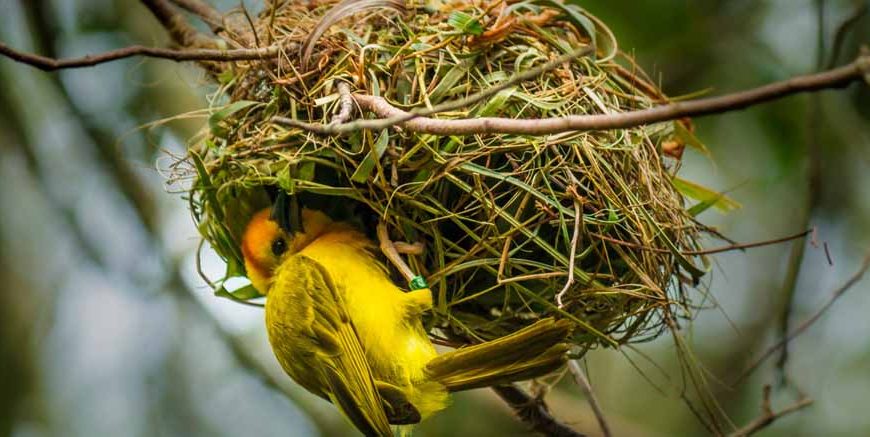Birds are extraordinary engineers who create elaborate and various constructions for their young. These homes differ in size, shape, and intricacy, all of which indicate birds’ amazing flexibility and cleverness. In this blog, we shall explore different kinds of bird nests, the materials used in making them, and how birds build their nests themselves. Whether you love birds or are interested in natural history topics, be prepared to be amazed by what follows.
Table Of Contents:
- Types of Bird Nests
- How Do Birds Build Their Nests?
- Amazing Bird Nests Worldwide
- Building Blocks Of Nature: Bird Nesting Material
- Amazing Bird Nests In India: A Detailed Look
Types of Bird Nests
Different types of bird nests are made by birds depending on their specific needs and surroundings. Some common types include:
- Cup Nests:
- Platform Nests:
- Cavity Nests:
- Pendulous Nests:
- Scrape Nests:
These are the most frequently seen among all others. They are usually bowl-shaped and consist of twigs, grasses, or mud. Trees or shrubs serve as robins’ and sparrows’ cup nest locations.
These nests have flat surfaces supported by tree branches, cliffsides, or ground level. Due to their large sizes, they are sometimes very solidly built and require strong materials like sticks, etc. Eagles’ platform nests fall under this category.
Nest boxes are man-made structures that offer similar conditions to those found in tree hollows where certain kinds of birds, such as woodpeckers and parrots, live.
Grasses woven together using spider silk makeup pendulous nests that hang down from branches loosely connected at points such that they can sway easily. You may be familiar with weaver birds’ beautifully crafted pendulous nest structures.
These feature simple designs consisting of shallow depressions on the ground lined sparsely with leaves or stones, etc. Shorebirds prefer this type, while some ground-nesting species also use it occasionally.
How Do Birds Build Their Nests?
The process involved when building a nest is indicative enough for us to appreciate just how skilled and determined these creatures can be; they never give up until everything falls into place according to their wishes. This starts with identifying an appropriate site where different factors must be considered, including safety from predators and harsh weather conditions, among others.
- Site Selection:
- Gathering Materials:
- Construction:
- Reinforcement:
Safety is paramount during this stage;. Thus, birds select sites that can offer them protection from enemies or adverse climatic changes that may affect their offspring’s survival rates negatively; hence, they must thoroughly check out many potential spots before settling on one.
Natural elements such as twigs, leaves, feathers, and artificial ones, like string paper, constitute bird nesting material. However, it should be noted that these animals are highly resourceful and hence will always make the best use of whatever is available within their reach at any given time, depending on prevailing circumstances around them.
In order to build its nest, a bird uses its beak feet sometimes even body parts if necessary for instance weaving moulding or shaping various components into desired shapes through repetitive actions until entire structure takes proper shape; this process may take days weeks depending on complexity involved in creating particular kind of birds’ nest being constructed.
There are instances when some birds need extra reinforcement either by adding more layers / materials onto existing ones so that their homes become stronger, healthier looking plus ensuring they remain firm throughout the breeding season without collapsing easily underweight eggs, young ones or strong winds and other natural elements. Hummingbirds do this using spider silk which binds nests together, making them more elastic and durable than would otherwise have been the case were it not included during the construction.
Amazing Bird Nests Worldwide
The wide range of diversity observed among avian species globally regarding building abilities displayed while constructing homes for themselves demonstrates just how flexible these creatures can get when faced with different environmental conditions around the world. Below are a few examples:
- Baya Weaver’s Pendulous Nest:
- Communal Nest of the Sociable Weaver:
- Nest Made of Saliva of Edible-Nest Swiftlet:
- Towering Nest of Osprey:
- Sealed Nest of Hornbill:
Found in parts of India, the Baya weaverbird’s pendulous nest constitutes an architectural wonder because males construct these structures to attract females who choose the best designers among competing suitors.
In deserts across southern Africa, the Sociable Weaver makes enormous nests for many birds. These are made of twigs and grasses that protect against predators and extreme temperatures.
The Edible-nest Swiftlet found in Southeast Asia builds its nest entirely from saliva. These nests are considered a delicacy and are harvested to make bird’s nest soup. The construction process represents an interesting case of biological adaptation.
Ospreys make large platform-like nests on tall structures such as trees, cliffs or man-made platforms. Every year, they utilise these nests built with sticks lined with softer materials; new levels are added during each breeding season.
Female hornbills seal themselves inside tree cavities using mud, droppings, food items, etc., leaving only a small slit through which the male feeds her and the chicks. This protects them from other animals wishing to eat their eggs or harm them in any way while keeping up close contact between parents and offspring.
Building Blocks Of Nature: Bird Nesting Material
The selection of bird nesting material is critical for successful nesting. Birds often use various types of materials together to achieve the strength, insulation, and camouflage balance required by each species.
- Twigs And Sticks –
- Grass And Leaves –
- Mud And Clay –
- Feathers And Fur –
- Human-Made Materials –
Many birds create a framework for their nest using twigs sticks, providing a strong base. Magpie crows are known for being skilled at arranging these materials.
These serve as lining materials that offer insulation comfort within the structure itself. Grass leaves are extensively used by songbirds and ground nesters, among others.
Some birds, like swallows, construct their homes out of mud clay, which can be moulded into shape easily yet withstand harsh weather conditions such as rain and strong winds, making it an excellent choice when building durable structures.
Soft feather-like substances from animals, such as birds’ feathers or fur make good lining materials because they provide warmth and cosiness necessary during the incubation stage when eggs need to be kept at specific temperatures for proper development. Pigeons doves use this type of stuff quite often while creating nests.
In urban environments where there may not always be enough natural resources some species have adapted by utilising man-made ones like string paper plastic etc., since these could work just fine but sometimes pose danger if not handled properly.
Amazing Bird Nests In India : A Detailed Look
India boasts numerous ecosystems, harbouring a wide range of birdlife and corresponding nest types. Below are examples worth noting:
- Indian Robin’s Nest:
- Tailorbird’s Stitched Nest:
- Purple Sunbird’s Pendant Nest:
- White-throated Kingfisher’s Burrow Nest:
Garden areas of open woodlands serve as habitats for Indian Robins, which usually build cup-shaped nests in crevices using grass, leaves, and even human-made objects occasionally.
Common tailorbirds create unique leaf-threaded homes stitched together with spider silk, which is commonly found among shrubs and small trees.
Purple sunbirds make hanging nests made from fibres, leaves, and spider silk. These nests are often suspended on tree branches and blend well into the surroundings.
These kingfishers dig burrows in riverbanks/termite mounds, hiding their nests securely inside them. The burrows are lined with grass feathers.
Bird nests are a captivating indication of how smart and flexible birds can be. This is evident in the complicated pendulous nests built by the Baya Weaver and the communal structures made by the Sociable Weaver, among others. Bird nests come in various architectural designs and building methods. It is amazing to learn about different kinds of bird nests and what materials are used because this knowledge not only makes us value these creations but also shows why it is necessary to preserve their environments.
At EuroKids, we know that curiosity should be nurtured while still young and that love for nature develops early enough. This is why our approach to preschool teaching considers all aspects of a child’s growth. Let us join hands in preparing future lovers of environmental conservationism who will care for our planet better than anyone else can ever do! Visit EuroKids today for more information on this subject matter!
Sources:
Bird Nests – (ansp.org)
https://avianreport.com/nests-of-birds/
A guide to bird nests: how, where and why birds make nests – Discover Wildlife
















